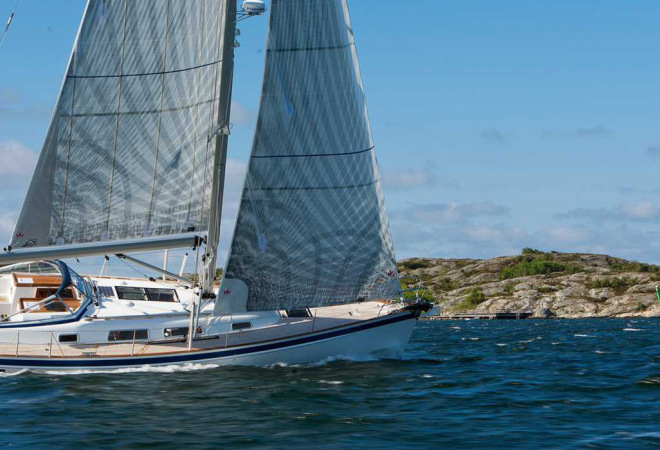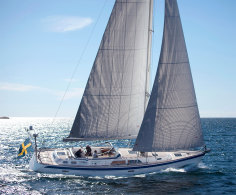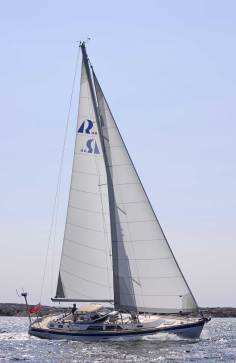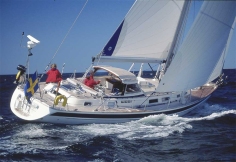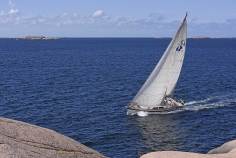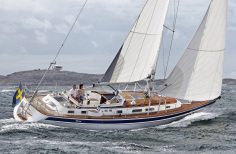n our modern time when boat building has not been spared series building or mass production, it is good to know that the Hallberg-Rassy yard existed in the days when boat building still meant wood and individual boats. In view of this we have specialized, from the earliest days, in comfortable sailing boats suitable for longer voyages. The company history started with Harry Hallberg back in 1943.
Harry Hallberg
What today is called Hallberg-Rassy Varvs AB was originally two yards.
Harry Hallberg, who lived between 1914 and 1997, commenced his boatbuilding career as a boy of 14, constructing boats made of wood. In 1943 he opened his own yard at Kungsviken on the island of Orust in Sweden.
At first, he built his wooden boats more or less by instinct. Different possibilities were discussed with the customer and solutions pointed out. Blueprints hardly existed at all. It was said that: "Someone who cannot build a boat without drawings cannot call himself a real boat builder".
The first boat to be built in a series was the Folkboat. He also had good success with Kungskryssaren (Swedish for the king’s cruiser), not to be confused with the Finnish King’s Cruiser which has nothing at all to do with Hallberg-Rassy. The Kungskryssaren was constructed in the mid-50’s. Both the Folkboat and Kungskryssaren was also built by other yards.
Harry Hallberg’s most distinguished contribution was his understanding of the advantages of using GRP and to build boats in a series. In 1963 he was one of the pioneers in serial production of sailboats using GRP. He was the first successful builder of GRP hulls with wooden superstructure in a series. His P-28 was a great accomplishment and in many aspects a forerunner.
Christoph Rassy
Christoph Rassy was brought up in Bavaria in the south of Germany by a lake named Starnberger See. As a young guy, he in his spare time built models of boats and also real boats. He wanted to learn more about boats and became an apprentice at a small yard for wooden boats in southern Germany.
Soon he wanted to build and sail larger and finer boats and wanted to live by the sea. He thought that Sweden, a large country with lots of water, was bound to build large and splendid boats. Consequently, he wrote to many Swedish boatyards, requesting work. One yard wrote that they would welcome him, and in 1960 Christoph moved empty-handed and with a bicycle as his only possession to Nötesund, Sweden to build boats. During the day he built boats for a boatyard that has now been out of business for many years.

The shed where it all started, both for Mr Hallberg and for Mr Rassy, although they actually never worked together as partners
The Kungsviken yard
To stretch his cash flow young Mr Rassy built boats for himself in his spare time. He raced these boats, won, and sold them at a profit.
Soon Christoph Rassy wanted to strike out on his own. As luck had it, this coincided with a leading boat builder's change of premises. This boat builder was Harry Hallberg. In the mid-60’s the yard at Kungsviken had become too small for Mr Hallberg and he built new premises in Ellös, 10 kilometres to the southwest on the island of Orust.
When Christoph Rassy started his own business he bought the old Hallberg yard in Kungsviken.
Harry Hallberg and Christoph Rassy were competitors 1965-1972
In the years of 1965 to 1972, Harry Hallberg and Christoph Rassy were competitors. At first, Christoph Rassy built boats on a one-off basis.
The first boat that became part of a series was the "Rasmus 35", designed in 1966 by the then leading Swedish designer of elegant yachts, Olle Enderlein. The first two were built entirely in mahogany and took one year each to construct. This boat was in many ways ahead of its time. It was a pioneer long distance cruiser with a powerful engine and a centre cockpit protected by a windshield. This is a design that has remained with the Hallberg-Rassy yachts to this day. When the Rasmus was presented many eye-brows were raised. Some thought that the boat was much too large. In those days 35 feet was regarded as an enormous boat size. In addition, it was a sailing boat with a windshield. This was a combination never seen before. Today it is taken for granted on a good cruising boat.
At the same time Harry Hallberg built his boats in Ellös. Smart, attractive boats at a reasonable price, thanks to serial production and GRP hulls.
Two yards became one: Hallberg-Rassy
Harry Hallberg retired in 1972. Again, fate intervened; Christoph Rassy was looking for larger premises. Ellös now produced the "Mistral 33" featuring a superstructure of mahogany, the 1/2 ton "Mistress 32", the best-selling "P-28" and the little yellow 24 ft "Misil II", all designed by Olle Enderlein, with the exception of the P-28 which was designed by Harry Hallberg.
In 1972 the Rassy yard in Kungsviken purchased Harry Hallberg’s yard in Ellös. As the Hallberg brand was by far the most well-known with its four designs and the Rassy yard only had the Rasmus; the new company was named Hallberg-Rassy.
Harry Hallberg and Christoph Rassy, however, have never been partners.
As a matter of curiosity, we like to tell about a prospective boat-buyer, who in 1972 was torn between buying a Mistral 33 from the Hallberg yard or a Rasmus 35 from the Rassy yard. The Rasmus had centre cockpit and the Mistral had aft cockpit. The prospect asked a salesman at Hallberg’s why he should choose the Mistral: "- As the boat has an aft cockpit you do not risk water splashing into an aft-cabin" was the answer. The prospective buyer later went to the Rassy yard to look at the Rasmus. The following discussion took place: Prospective buyer to Mr Rassy:
- Why not a boat with an aft cockpit, so you do not get water splashing into the aft cabin?
- Who recommends that? Mr Rassy asked.
- The people at Hallberg’s at Ellös.
- They will never say that again.
- Why not?
- I bought the Hallberg yard this morning.
A Rasmus was ordered. This boat has the same happy owner to this day.
And by the way; the water does not splash into the aft-cabin!
The bestseller - the Monsun 31
The first new design under the name of Hallberg-Rassy was the Monsun 31, which was created in 1973 and launched 1974. The boat proved a great success, and 904 were built up to 1982, the highest number of units built of any kind of Hallberg-Rassy to this date.
To meet the demand the area of the yard was doubled in 1975.
Hallberg-Rassy 41 - the new flagship
The next design was the Hallberg-Rassy 41. This quickly became a trendsetter. This was the first boat with a proper walk through to the aft-cabin below deck. The basic principle for the layout, though greatly improved, is used to this day. One can question if this is due to routine or if this represents the optimal interior design of a centre-cockpit boat. On further study it becomes rather evident that this is indeed an optimal design.
The Hallberg-Rassy 41 had free passage from stem to stern below deck in one level. The galley was placed at starboard by the stairs, out of the way from any passers-by, providing safety at sea and providing full headroom in the whole galley. The chart table on the opposite side was generous and with a real seat in the boats heading direction.
Further the Hallberg-Rassy 41 was a long distance vessel with the keel and rudder separated, and among other things a blue brim around the cockpit, which was slightly elevated, to give room for the passage below deck.
The size of the boat and the outfitting was spectacular for its time: Pressured water, heated water, shower, electric anchor winch, headsail furling system, two separate heads, a powerful engine, solid and elegant wooden interior and gracious lines.
All this is basic, though very much improved, to this day. Over 100 units of the Hallberg-Rassy 41 were built during a short but intense period from 1975 to1979, a few were also built until 1981.
Hallberg-Rassy 38, designed in 1976/77, was also a trendsetter with the same interior concept, though a higher freeboard, and was the first boat with the characteristic blue stripe around the hull.
The Hallberg-Rassy 352 from 1977/78 was a substantial sales success, with more than 800 built until 1989. This was the first time a designer had managed to combine, in a 35 foot boat, a walk through to the aft-cabin with spectacularly elegant lines. Hallberg-Rassy 352 offered large-boat characteristics at a moderate price.
An ad for the Hallberg-Rassy 312 from 1979 said: "The new fast long distance cruiser. It is easy to recognize the new Hallberg-Rassy 312, by its contemporary lines and the design which has become characteristic for yachts from Hallberg-Rassy; an elegantly laid teak deck, a modern and easy to handle rig, ample elbow-room inside and exquisite woodwork." 690 Hallberg-Rassy 312s were built up to 1993.
The Hallberg-Rassy 49, which arrived in 1982, was with its 15 meter hull an imposing flagship for the Swedish boat industry.
One-off boat Rassker
In 1983, 16-year old Magnus Rassy designed and built an experimental boat named "Rassker". The hull was built in high tech aramid fibre and Divinycell. This was the first boat built at Hallberg-Rassy to feature an external lead keel and a stern with a bathing platform. The hull length was 26 ft and the boat won many races.
Hallberg-Rassy 382 - the final Enderlein design
The Hallberg-Rassy 382 came in 1984 and was the last Olle Enderlein design and the last model with the keel moulded into a GRP encapsulated sump. So in a way this model was an end of an era. 120 boats were built between 1984 and 1992.
Armchairs in 1985
In 1985 two armchairs were built in to the saloon of a Hallberg-Rassy 49. This was something no one had seen on a yacht before. Now you can find similar solutions on boats built by yards all over the world, but no armchairs are as comfortable as the original ones by Hallberg-Rassy.
One-off Rassker Magnum
In 1987, another boat designed by Magnus was built, the 35 ft "Rassker Magnum". Also this boat was racing very successfully. These two boats were nothing for Hallberg-Rassy to put on the market, but a good preparation for future developments. Today, many of the features are used in the current production boats. The Rassker boats provided many new ideas for future Hallberg-Rassy models, at the same time offering ideas on what they should not look like. For instance the importance of a proper, deep bilge and an easy to handle rig became evident. Some years later, the experiences from this boat resulted in a new revolutionary boat, the Hallberg-Rassy 34.
Own hull lamination from 1987
In 1987 Hallberg-Rassy also purchased a factory, which for many years had functioned as a subcontractor for the GRP hulls. Since 1987 Hallberg-Rassy Marinplast AB is a wholly owned subsidiary of Hallberg-Rassy AB.
That means that Hallberg-Rassy has full control over the complete construction cycle, both wood and GRP works. Hallberg-Rassy Marinplast has never built hulls for anybody other than Hallberg-Rassy, in spite of rumours to the contrary.
Germán Frers - the most talented Naval Architectures of our time
In 1988 Hallberg-Rassy began a successful co-operation with the most talented yacht designer of our time - Germán Frers (pronounced Herman Frers) from Argentina. Frers is as well known for his Superyacht designs, as he is for drawing cruising yachts with elegant lines. Frers comes from a true boatbuilding family. Hallberg-Rassy has always been renowned for its sturdiness, seaworthiness, comfort, safety, and fine wood-work. The latest generation Hallberg-Rassy yachts also offer you the best that you can buy for the future with regard to elegance, performance, and ease of handling.
Several victories in for example the ARC over the Atlantic or Tjörn Runt shows that a modern cruiser does not have to be lacking in performance. Germán Frers has so far made 20 designs for Hallberg-Rassy, in chronological order the Hallberg-Rassy 45, 36, 34, 42F, 39, 31, 53, 46, 62, 43, 40, 37, 48, 342, 54, 372, 310, 64, 412 and the new model for 2013; Hallberg-Rassy 55.
So far Hallberg-Rassy has delivered 9,200 yachts, of which Frers designed 3,200.
Hallberg-Rassy 45 - the first Frers design
When the Hallberg-Rassy 45 was launched in 1988 it was a trendsetter. This was the first Hallberg-Rassy designed by Germán Frers.
The Hallberg-Rassy 45 introduced an external lead keel in serial production, a sturdy hull stiffener along and across the boat, between the floor and the keel, which reinforces the construction considerably. In addition it introduced a hull insulated with Divinycell foam core, which not only insulates from heat and cold, it also ensures an even firmer hull with a smooth inside, in contrast to the stringers of old days.
The Hallberg-Rassy 45 claimed overall victory in the ARC over the Atlantic, in competition with a range of vessels from Whitbread boats and racers/cruisers to smaller family style boats.
The revolutionary Hallberg-Rassy 34
1990 the almost revolutionary Hallberg-Rassy 34 was launched. Three years earlier the then 20 year young Magnus Rassy created his own experimental boat, the 35 ft Rassker Magnum because he wanted a boat that was a joy to sail. That boat gave a lot of experience in good things and things that were not so good. For instance the importance of a proper, deep bilge and an easy to handle rig became evident. The good things were sailing performance and the knowing this can be combined with a comfortable boat. When the Rassker Magnum was sold in spring 1990, the decision was quickly taken to develop a new production Hallberg-Rassy, with the best from Rassker Magnum, adding both further comfort and performance. The new boat should be Frers designed with greatly improved performance compared to earlier production Hallberg-Rassys and a look that can be described so contradictory as younger, yet classic at the same time. This should be done without sacrificing all the good old Hallberg-Rassy qualities such as sturdiness, seaworthiness, comfort, safety, and fine wood-work. Frers was contacted with this design brief and summer 1990 the first Hallberg-Rassy 34 sailed. The model came to be a commercial success and a forerunner for a whole new generation Hallberg-Rassys.
New 53 ft flagship
In 1992 a new flagship was launched, the Hallberg-Rassy 53. 82 boats were built during fifteen years, from 1992 until 2006.
Hallberg-Rassy NewsLetter introduced 1995
Every year since 1995 a printed Hallberg-Rassy NewsLetter has been relesaed. It contains interesting insidernews from Hallberg-Rassy. You may download each issue at the Download section.
Website introduced 1996
When the Hallberg-Rassy web site got online back in 1996, it was one of the very first web sites for any boatbuilder in Europe. Already then it was unusually extensive.
Since April 2011 Hallberg-Rassy has a very active Facebook account, and since the fall 2013 there is an Intagram account.
First GRP boat in a museum a Hallberg-Rassy
In 1996 the Hallberg-Rassy Monsun 31 "Golden Lady" retired into a museum, after three and a half circumnavigations. The Swedish sailor Kurt Björklund donated his boat to the maritime museum in Råå in southern Sweden. Kurt Björklund is the first owner and took delivery of this boat here in Ellös 1974. Kurt knew that he wanted to do some serious sailing, but could never have imagined how far he would travel. In 1983 Kurt retired from work and went on his first solo circumnavigation. The second one included the rounding of Cape Horn. - I could have sold the boat for some SEK 300 000 But I could not stand the idea of not knowing where the boat was and how she was doing. I prefer sacrificing the money and have peace in my mind, Kurt said, who lived between 1921 and 2006.
Separate company for spare parts and accessories founded
In 1998, a separate company was founded, to deal with original Hallberg-Rassy spare parts and accessories. Today Hallberg-Rassy Parts AB is a company within the Hallberg-Rassy group and employs four persons purely dedicated to dealing with this. In the web shop www.hr-parts.com you find thousands of items with photo and pricing.
Yet a larger flagship
The time had come for yet a new dimension and yet a larger flagship. The Hallberg-Rassy 62 was presented on the drawingboard 1997 and had world premiere at the boatshow in Düsseldorf January 1998. 25 boats were built until 2011.
Shoeless Queen visited Hallberg-Rassy
In 1999, His Royal Majesty, the King of Sweden, Carl XVI Gustaf, visited the Hallberg-Rassy 53 at the boat show in Düsseldorf, accompanied by Her Royal Majesty, the Queen of Sweden, Silvia. Both the King and the Queen took their shoes off when visiting this beautiful boat, as the maritime tradition tells to do. How many else have ever seen a shoeless Queen?
Hallberg-Rassy 43
In August 2001, as model year 2002, the Hallberg-Rassy 43 was introduced. Sales really exploded and the model won many awards;
- Yacht of the Year in Germany,
- Best Midsize Cruiser in the USA,
- Best overall Cruisingboat in the USA as well as
- Top 10 in the US and
- Import Boat of the Year in Australia
Hallberg-Rassy 40
At the Open House weekend August 2002, as model year 2003, the Hallberg-Rassy 40 was introduced. She won a further bunch of prizes;
- European Yacht of the Year in the largest category
- Overall winner in Boat of the Year in USA 2004
- Best Liveaboard cruising boat in USA 2004
- Sailboat of the Show in Stockholm
The Supercabin
At the Open House Weekend in August 2006 the new Supercabin layout forward of the mast was introduced. Most Hallberg-Rassy yachts are sailed by one or two couples. Only occasionally is there a need for a third cabin. With this in mind, Hallberg-Rassy developed a new alternative Supercabin layout forward of the mast. That means there are two high priority double cabins and one more two-berth cabin in the front for occasional use. Apart from the comfortable aft cabin there is now also a very generous cabin in front of the mast with a double berth and lots of elbow space. The V-cabin in front is still there and the actual berths are not smaller than they normally are but the hanging locker and the floor area of the V-cabin has been reduced in favour for the super cabin forward of the mast.
New lamination workshop 2007
In 2007 a new lamination workshop was built at Hallberg-Rassy Marinplast in Kungshamn. When the older workshops were built, the largest yacht these had to accommodate was a thirty-five footer. The new workshop has space for the simultaneous building of two large yachts, which corresponds a lot better with both the current and the future product mix.
New head office 2008
In 2008 Hallberg-Rassy opened a new head office. The new office building is situated partly on the water, resting on pillars.
The office is part of the harbour and the demonstrator boats are found just outside the office windows. There is also a large mooring deck. At the far end of the building above the water there is a large conference room.
The new head office hosts the sales department, reception, financial department, development and CEO. There are also guest showers and toilets that have easy access from the outside.
The offices that moved down to the harbour gave place for a state of the art varnishing machine, for which there was no space before.
Hallberg-Rassy 372
Already the very first day the Hallberg-Rassy 372 was launched, August 2008 for the 2009 season, this was reported: What a great day! Already from the first moment it was clear: the new Hallberg-Rassy 372 sails like a dream! She is quick, easy to steer and she is great fun to sail, always under control. She exceeds all high expectations. She has wonderful sweet lines, even more beautiful in reality than on the synthetic images. This is another milestone in Hallberg-Rassy's history."
No wonder the Hallberg-Rassy 372 both won European Yacht of the Year 2010, Luxury Cruiser and was also concluded Best in Test in a large comparison between 8 fast 37 footers in Seilas magazine from Norway.
New flagship - the Hallberg-Rassy 64
The Hallberg-Rassy 64 is the greatest Hallberg-Rassy ever built. The world premiere took place at the Düsseldorf boat show in 2011. The Hallberg-Rassy 64 was the largest sailboat at the world's largest boatshow.
The Hallberg-Rassy 64 is a world cruiser for a family crew - operated by Push Button Sailing.
The Hallberg-Rassy 412
In 2012 the Hallberg-Rassy 412 was introduced. It is the largest aft cockpit Hallberg-Rassy ever built. It is the first time twin aft cabins are offered on a Hallberg-Rassy. She is a comfortable cruiser that wins races. The first Hallberg-Rassy 412, with in-mast furling, won her category in Tjörn Runt 2012, among 48 boats, both on calculated time and actual time. This shows that at comfortable cruising boat doesn't need to lack in performance.
2013 the Hallberg-Rassy 412 won the title Sailboat of the Year in Sweden in the Luxury category.
Hallberg-Rassy today
Everything started 73 years ago in the heart of the Swedish archipelago. Today 9,400 Hallberg-Rassy yachts are delivered all over the world. There are Hallberg-Rassy ambassadors in the very cold areas of the world as well as in tropical heat. Many of the features that help to protect against the cold, work just as well protecting against the heat and intensive sunshine. For example the wind screen with sprayhood canopy or the insulated hull. A Hallberg-Rassy is dedicated to world wide cruising. The success confirms that the Hallberg-Rassy concept is right.
The last few years’ business for Hallberg-Rassy includes orders from Andorra, Angola, Argentina, Australia, Austria, Belgium, Bulgaria, Canada, Chile, China, Croatia, Czech Republic, Denmark, Faeroe Islands, Finland, France, Germany, Greece, Hong Kong, Hungary, Indonesia, Ireland, Israel, Italy, Japan, Latvia, Lithuania, Luxembourg, the Netherlands, Norway, New Zealand, Oman, Poland, Portugal, Qatar, Russia, Saudi Arabia, Slovenia, Spain, Sweden, Switzerland, Turkey, Ukraina, United Arab Emirates, United Kingdom and the USA.
We have stayed true to the concept of sturdy craft, well protected cockpits, high endurance and good sailing qualities with a high degree of comfort. The boats are easy to handle by a small crew. All this means we can build long series of boats with a quality that is affordable.
Have a look at a Hallberg-Rassy! Come on board! The superb woodwork gives it an unmistakable atmosphere.
The Hallberg-Rassy group of companies are to 100 % owned by the Rassy family. Hallberg-Rassy is since 2003 headed by the second generation; Magnus Rassy. Hallberg-Rassy has never had financial troubles. Every buyer may get a bank guarantee at low cost price. Every Hallberg-Rassy yacht is delivered right on time.

